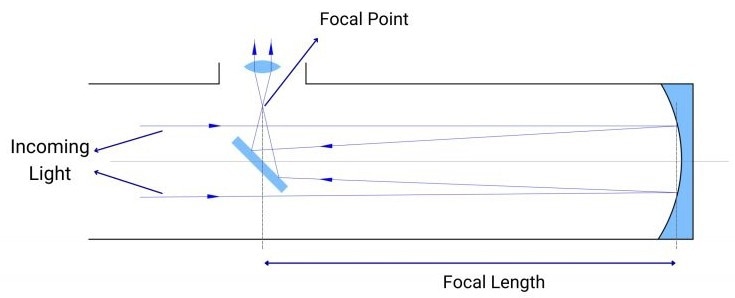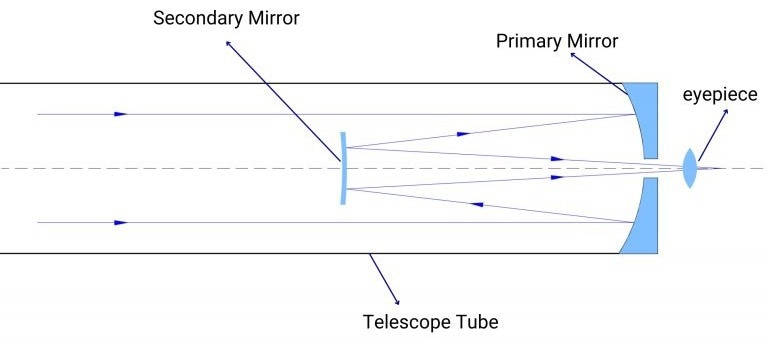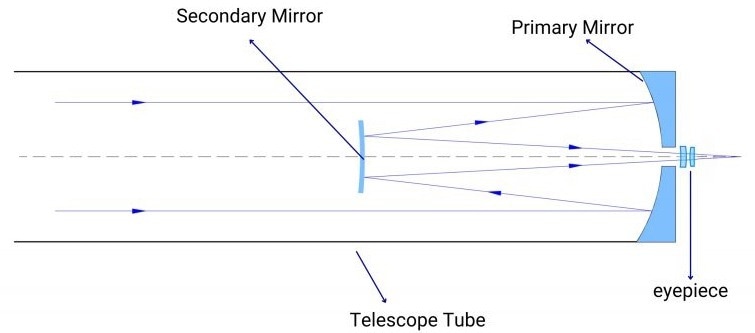The Ritchey-Chrétien (RC) telescope is a specialized reflecting telescope within the Cassegrain optical system, developed by George Ritchey and Henri Chrétien in 1910. Known as the “RC Telescope,” after the initials of its inventors, this design eliminates chromatic aberration—a common issue in refracting telescopes—due to its reflective nature.
Typically coated with metal, reflecting telescopes like the RC can function across a broad spectrum of wavelengths, from visible to infrared light. This broad range capability is a key reason why many astronomical observatories choose reflecting telescopes for their powerful and versatile performance in various observational contexts.
Reflecting Telescope
Newton developed the first reflective telescope, which used a spherical mirror. However, spherical mirrors are known to suffer from spherical aberration, which is directly proportional to the cube of the aperture size. This restricts the F-number and picture quality.
Regardless, spherical mirrors offer certain benefits. They have several rotational symmetry axes, resulting in a more consistent picture quality across the field of view. This makes them ideal for systems with a narrow relative aperture and minimal picture quality requirements.
However, as shown in the spot pattern of a Newton telescope with an F=8.3, spherical aberration reduces picture quality over the entire field of view.

Image Credit: Shanghai Optics
Cassegrain System & RC Telescope
While reflective telescopes have numerous advantages, they do suffer from spherical aberration. To overcome this, optical designers have created a variety of approaches and telescope variations. One classic design adds a convex mirror to the structure.
This not only minimizes the telescope’s overall length but also improves the picture quality due to the additional flexibility offered by the convex mirror. This design is referred to as the Cassegrain system.
A Cassegrain system consists of two mirrors: a concave (or primary mirror) and a convex (or secondary mirror). The secondary mirror blocks a portion of the light.
The ratio of the diameter of the blocked light to the diameter of the input beam is called the light block coefficient. A system with a substantial light block will experience high energy loss and a reduced image quality. As a result, it is critical to select an adequate blocking ratio during the design phase.
The primary mirror of a traditional Cassegrain telescope is normally a paraboloid. The paraboloid provides an equal optical path, thereby eliminating the problem of spherical aberration. However, a paraboloid has only one axis of rotational symmetry.
If the light beam does not strike it perpendicularly, it can increase coma as the field of view expands. There is also some degree of astigmatism and field curvature.
Consequently, while this telescope’s axial picture quality is good, the off-axis picture quality is less than ideal, restricting the available field of view. For example, an F=8.3 Cassegrain telescope achieves the diffraction limit in the axial field of view but shows a noticeable coma in the off-axis field of view.

Image Credit: Shanghai Optics
RC Telescope Advancements
The RC telescope was designed around the Cassegrain system, with hyperboloids serving as both the primary and secondary mirrors. The RC telescope successfully removes most spherical aberrations and comas.
Although the on-axis image mass drops slightly compared to parabolic reflection systems, this decrease is not substantial. The elimination of the coma improves the off-axis picture quality of the RC telescope, resulting in a more uniform picture quality.
However, the RC telescope has not fully addressed the concerns of field curvature and astigmatism. The light spot commonly expands elliptically as the field of view increases. To solve this, field lenses can be placed in front of the RC telescope’s image field to correct aberrations, hence enhancing image quality.

Image Credit: Shanghai Optics
RC Telescope Summary
RC telescopes are reflector telescopes featuring hyperboloids on both the primary and secondary mirrors. Compared to other types of Cassegrain systems, RC telescopes can have a greater relative aperture, usually between F6 and F10.
The picture quality on the axis can easily exceed the diffraction limit, and in certain fields of view, the off-axis picture quality can also be maintained effectively. The picture quality of a larger field of view can be further enhanced with compensation lenses.
However, RC telescopes have certain disadvantages. The telescope’s structure causes a blackout, which results in energy loss.
In addition, the structure is prone to producing substantial aberrations owing to eccentricity, necessitating exact alignment and maintenance. Moreover, hyperbolic mirrors are more difficult to process and costly than spherical or other types of reflectors.
Despite these obstacles, the RC telescope has had a significant impact in certain fields, particularly in astronomical observation.

This information has been sourced, reviewed and adapted from materials provided by Shanghai Optics.
For more information on this source, please visit Shanghai Optics.